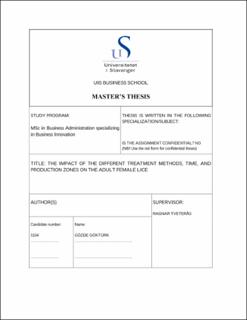| dc.contributor.advisor | Tveterås, Ragnar | |
| dc.contributor.author | Göktürk, Gözde | |
| dc.date.accessioned | 2020-11-23T08:58:40Z | |
| dc.date.available | 2020-11-23T08:58:40Z | |
| dc.date.issued | 2020-07 | |
| dc.identifier.uri | https://hdl.handle.net/11250/2688990 | |
| dc.description | Master's thesis in Business innovation | en_US |
| dc.description.abstract | The aquaculture sector is ever-growing since the 1980s, however, several challenges influence the growth of the industry. One of the core issues is the parasites, named “sea louse”, that attach to the fish and deteriorate the quality and health of the fish. In this master thesis, the longitudinal data extracted from Barents Watch has been used in the empirical studies to analyze the dependence of adult female lice on the cleaner fish, mechanical removal, in-feed, and bath treatment, as well as the time and production zones. Three different regressions are applied to measure the effect of treatment methods. The first regressions suggest that the cleaner fish, mechanical removal, and in-feed treatment methods have a negative impact on the adult female lice at the 10% level of significance, whereas the bath treatment significantly and positively influenced the dependent variable at the 1% significance level. After converting the independent variables for the treatment methods (excluding the cleaner fish) into binary values, the mechanical removal and in-feed became insignificant while the bath treatment maintains its significance and positive effect on the adult female lice. The last regression showed the dependence of adult female lice on the cleaner fish and mechanical removal has been affected negatively and significantly in the random effects GLS regressions. However, the in-feed treatment became once more insignificant and the bath treatment remains a positive and significant impact on the dependent variable. In all the three regression models 13.20% - 14.14% of variation can be explained by these economic models, which indicates that there are other factors that influence the positive effect of bath treatment method or insignificance of in-feed or mechanical removal in some of the models. The time and production zone dummy variables are inserted into the model for each treatment successively. The F-test conducted to investigate the joint significance of all the year regressors and the production zone regressors. The outcome pointed out that both the year and zone regressors are statistically and jointly significant at the 1% statistical significance level. | en_US |
| dc.language.iso | eng | en_US |
| dc.publisher | University of Stavanger, Norway | en_US |
| dc.relation.ispartofseries | Masteroppgave/UIS-HH/2020; | |
| dc.rights | Navngivelse 4.0 Internasjonal | * |
| dc.rights.uri | http://creativecommons.org/licenses/by/4.0/deed.no | * |
| dc.subject | økonomi | en_US |
| dc.subject | administrasjon | en_US |
| dc.subject | akvakultur | en_US |
| dc.subject | sjølus | en_US |
| dc.subject | innovasjon | en_US |
| dc.title | The impact of the different treatment methods, time and production zones on the adult female lice | en_US |
| dc.type | Master thesis | en_US |
| dc.subject.nsi | VDP::Social science: 200::Economics: 210::Business: 213 | en_US |
| dc.subject.nsi | VDP::Landbruks- og Fiskerifag: 900::Fiskerifag: 920::Akvakultur: 922 | en_US |

